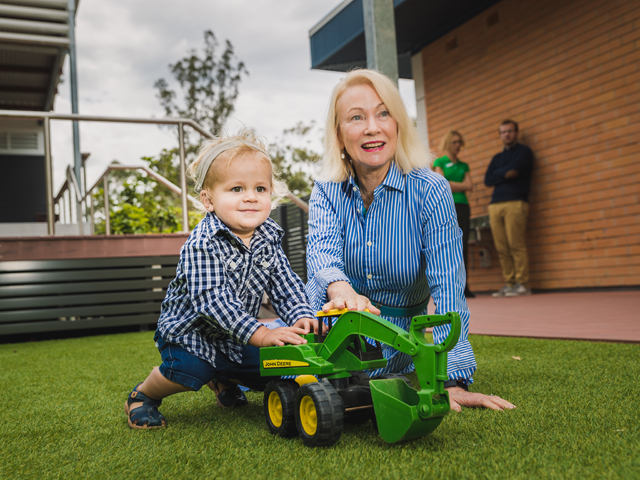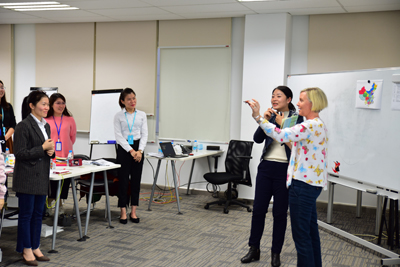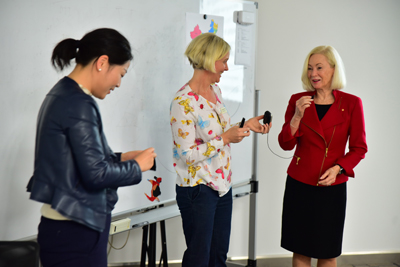Dimity Dornan Hear and Say Interview

These Four Australian Women are Changing How the World Hears
Three of Australia's most respected paediatric audiologists and speech pathologists from Hear and Say are conducting the first training program for 30 of China's professionals in Auditory-Verbal Therapy for children with hearing loss from 15 - 19 November in Suzhou, Jiangsu Province China.
Auditory-Verbal Therapy using Hear and Say's Listening and Spoken Language therapy coupled with access to assistive hearing technology, can open the possibilities for children who are deaf to develop the ability to speak and hear which allows them to access mainstream education and future employment opportunities.
Dr Dimity Dornan, Founder of Hear and Say, will be travelling with the team members to officially launch the training partnership. "We are thrilled that Hear and Say will play a role in equipping China's professionals, helping to deliver improved outcomes for China's children who are deaf."
The provision of this inaugural training has been made possible with sponsorship from leading manufacturer of innovative hearing care Sonova, Australian philanthropy group Fletcher Philanthropies and the Lee Long Family, who have subsidised part of the cost of delivering the training to improve the affordability for Chinese professionals.
Dr Dornan explains Hear and Say's involvement in training in China is indicative of the vital role Hear and Say undertakes to work globally to enhance speech and language for all children who are deaf. "We have 26 years of expertise, knowledge and Intellectual Property and we can now use this capability to make a global impact by training China's professional workforce of audiologists and speech pathologists in this technique."
While in China, Dr Dornan will present at the China Rehabilitation Center & China Rehabilitation Research Center for Hearing and Speech Impairment in Beijing. She will discuss Hear and Say's approach to telepractice and remote training for professionals and parents, as well as teaching listening and spoken language to children with hearing loss.
"This is just the first of many training programs we hope to undertake in China to ensure China's audiologists and speech pathologists are equipped with world-leading knowledge to give the children who are deaf in China a speaking future."
Hear and Say has been operating for 26 years and over this time thousands of children with hearing loss have been helped to hear, listen and speak – creating a future where they are not limited by deafness.
Interview with Dimity Dornan, Hear and Say's Founder
Question: What is Hear and Say?
Dimity Dornan: Hear and Say is a world-leading paediatric Auditory-Verbal and cochlear implant centre that has been teaching deaf children to listen and speak since 1992. We now employ more than 60 staff across five centres around Queensland, and via a Telepractice Program that serves rural, remote and international children and families.
We work with more than 900 children enrolled in our targeted Early Intervention Program, provide specialist support through our Cochlear Implant Program, and deliver our school hearing screening Program, Hear to Learn, to more than 10,000 school students each year.
Question: What originally inspired you to start Hear and Say?
Dimity Dornan: Early in 1991, having worked in other models of service delivery for children who are deaf or hearing impaired, and becoming interested in parent-based oral programs, I heard Judy Simser speak at a convention at the Gold Coast. The evidence of the progress of Judy Simser's Auditory-Verbal children was very compelling, as were her words of confidence in her outcomes.
How could I provide a similar Auditory-Verbal service for my clientele of outreach children who lived in Queensland but had to travel to The Shepherd Centre's auditory-oral program over a thousand kilometres away in Sydney? And what about the other children who were deaf/hearing impaired whose families wanted me to see them in my private practice but who could not afford the fees?
A Churchill Fellowship to study Auditory-Verbal Therapy with Judy Simser and Warren Estabrooks in Canada was awarded to me soon afterwards. My express purpose was to set up a charity Auditory-Verbal Centre. Following a wonderful six weeks in their clinics I returned home to good news – seed funding was available to start a clinic in Queensland and I was invited to join the new venture to take care of pre-implant preparation and post-implant habilitation.
I set up a charity board consisting of about 20 representatives including hearing professionals, business, finance, education and medical personnel. The Hear and Say Centre for children who are deaf/hearing impaired and their families was born on 6 July, 1992.
Question: What is an auditory verbal therapist?
Dimity Dornan: Audio verbal therapists specialise in a combination of listening and spoken language early intervention, to maximise listening and spoken language development. This therapy successfully develops the listening and spoken language of children with hearing loss by stimulation auditory brain development. This enables them to make meaning of what they hear and lay down pathways for speech and language development.
Question: Can you tell us about your most recent trip to China?
Dimity Dornan: Three of Australia's most respected paediatric audiologists and speech pathologists from Hear and Say conducted the first training program for 40 of China's professionals in Auditory-Verbal Therapy for children with hearing loss in mid-November in Suzhou, Jiangsu Province.
I was delighted to travel with the team members to officially launch the training partnership, thanks to sponsorship from leading manufacturer of innovative hearing care Sonova, Australian philanthropy group Fletcher Philanthropies and the Lee Long Family, who subsidised part of the cost of delivering the training to improve the affordability for Chinese professionals.
We are thrilled that Hear and Say will play a role in equipping China's professionals, helping to deliver improved outcomes for China's children who are deaf.
While in China, I was also invited to present at the China Rehabilitation Center & China Rehabilitation Research Center for Hearing and Speech Impairment in Beijing, where I talked about Hear and Say's approach to telepractice and remote training for professionals and parents, as well as teaching listening and spoken language to children with hearing loss.
Question: How do you think the five-day intensive training session went?
Dimity Dornan: The five-day training session program was highly successful, attended by 40 people and the feedback was extremely positive in every case, with all participants indicating that the training would be helpful in their practical work.
We did notice that using Chinese-English interpreters added another level to the training and we modified the sessions somewhat to address the timing issues related to this aspect.
Sessions were held on the campus of the manufacturing facility for Sonova, which is the only company in the world that produces both hearing aids and advanced bionics cochlear implants. They are unique in being able to offer a world of benefit to potential clients and it also sets a precedent for other companies to step up to that benchmark.
The Sonova Global Training Institute is special because they provide training for technology but they ask us to partner with them to do the brain training, without which the tech doesn't work.
Question: What is involved in sharing your world-leading practice globally?
Dimity Dornan: This work is conducted by Hear and Say WorldWide, our global Hearing Health Education and Development Program. Its education and training programs are provided to healthcare professionals across Australia and internationally. We aim to change the way the world thinks about and treats children with hearing loss.
Hear and Say's involvement in training in China is indicative of the vital role Hear and Say undertakes to work globally to enhance speech and language for all children who are deaf. We have 26 years of expertise, knowledge and Intellectual Property and we can now use this capability to make a global impact by training China's professional workforce of audiologists and speech pathologists in this technique.
 Question: How is this therapy life-changing?
Question: How is this therapy life-changing?
Dimity Dornan: Quite simply, the hearing technology doesn't work unless it is used in conjunction with brain training that allows the recipient to understand the new speech signal they are able to hear.
Auditory-Verbal Therapy using Hear and Say's Listening and Spoken Language therapy coupled with access to assistive hearing technology, can open the possibilities for children who are deaf to develop the ability to speak and hear which allows them to access mainstream education and future employment opportunities.
Question: How can Australians support Hear and Say?
Dimity Dornan: There are many ways that you can help us in our work, from hosting a fundraising event, attending an event, making a bequest in your will, volunteering or becoming a child champion. More info is available on our website: https://www.hearandsay.com.au/get-involved/
Question: What does Hear and Say hope to achieve in 2019?
Dimity Dornan: This is just the first of many training programs we hope to undertake in China to ensure China's audiologists and speech pathologists are equipped with world-leading knowledge to give the children who are deaf in China a speaking future.
The expectation is that these professionals will return and train others in their region. Eventually, we will adopt a train-the-trainer approach. We have invitations to go back to China in June next year. We are also considering appointing a new Chinese staff member at Hear and Say.
There might be a Japanese program after that and then I am going to India in January 2019 to do a follow-up training presentation for teachers of the deaf in Chennai. In Australia, we conduct ongoing professional training through the year. We have different levels available, online and also in person.
Interview by Brooke Hunter
MORE




